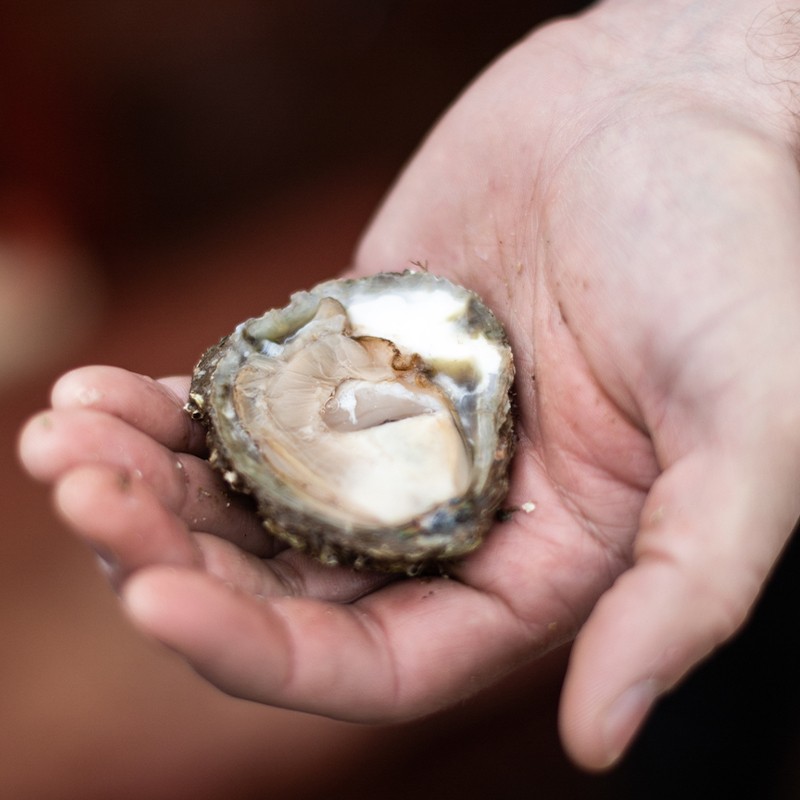It’s Oyster Season – Here’s How To Make The Most Of It

Why do you love oysters, Bobby?
Because they are part of my east coast heritage, which I take everywhere with me. And the taste of umami and salinity when eating an oyster is like nothing else on earth.
How did you make them the focus of your career?
I was born in Maldon, Essex, where a neighbouring farm ran the historic Maldon Oyster Company. I started working for them in my teens and have since worked for Oysters of Mersea Island – which has been run by the same family for eight generations – exporting oysters, selling them to restaurants, and shucking hundreds of thousands of them at markets. Since researching my book and travelling the coast on my motorcycle, I’ve been told that I’ve seen more oyster farms and fisheries than anyone else in the UK and Ireland. I work at Chiltern Firehouse these days, but maintain a strong working relationship with my former Essex employers.
What’s the difference between farmed and wild oysters?
A wild oyster will have grown on the beach and will be exposed to the air twice a day as it is covered by seawater twice a day with the tides. It tends to have a gnarly, tough shell compared to the more regular sculpted shell of an oyster that’s been tended to. Farmed oysters are amazing contributors to the environment – it is not the same as fish farming which can often get bad press.
And how about rock and native oysters?
Native oysters are indigenous to Europe and are only eaten from September to April. They are disc-shaped in appearance with a beige-coloured meat that sits in a shallow cup. Although each oyster is a product of its environment, natives tend to have a stronger, more gamey taste. Rock oysters are the most popular oyster in the world; they were introduced here from the Pacific in the last century. They are arrow or teardrop shaped, have a deep cup and white-coloured meat.
How should oysters be eaten?
A native oyster should be eaten au naturel or with a dash of lemon. Rock oysters are far more versatile and can be eaten raw, cooked, dressed or as part of another dish. If trying an oyster raw, always taste the liquor from the shell first to see if you should add anything to the oyster at all.
And when do you like to eat them?
In the 20th century, oysters were predominantly for celebrations and special occasions. However, I have had oysters in my life every week for the last 15 years and I can confirm they are a fantastic food to incorporate into a normal diet. In the 1800s and before, they were an affordable food stuff and now, since the onset of hatcheries and improved aquaculture techniques, people are once again tucking into oysters regularly, and not just in fine-dining restaurants.
Where are your favourite places to eat them?
This is a tough call as there’s a plethora of awesome oyster spots in the UK. For a start, the oyster cart at Chiltern Firehouse is one of a kind. Elsewhere in the capital, if I am feeling old school, Rules or Bentley’s. If I fancy a market experience, I’ll head to the Maldon Oysters stall in Chelsea’s Duke of York Square on a Saturday, Oyster Boy in Columbia Road on a Sunday or Richard Haward’s Oysters in Borough Market throughout the week. For something in between, I like Buffalo Fried Oyster by Boutall Bivalves at Grays & Feather or The Oystermen in Covent Garden, plus Seabird, Louie and Wright Brothers.
Around the UK, I’d recommend Riley’s Fish Shack and Saltwater Fish in Newcastle, Company Shed in Essex, Le Petit Bistro Guernsey, White Horse in Brancaster, Môr in Mumbles, the original Loch Fyne restaurant in west Scotland or Ondine in Edinburgh. In Ireland, there’s Moran’s in Galway, Klaw in Dublin, the Sligo Oyster Experience or Mourne in Belfast.


What’s the sign a restaurant knows its stuff when it comes to oysters?
A long-standing reputation helps or a dedicated shucker/shucking station where the oyster is treated with respect. In the appendix of my book, I’ve put together a long list of oyster eateries from beach shacks to fine dining – and I can vouch for these places.
When is the best time of year to eat oysters?
A wild oyster in spring or autumn is stunning, a native flat oyster in September and October is a delicacy, and rock oysters in summer are extremely refreshing.
What are your favourite ways to serve them?
Usually just with lemon, with guests having the option to choose between a seasonal mignonette or Tabasco. A classic mignonette sauce is based on red wine vinegar, and is thick with chopped shallot, black pepper and a touch of brown sugar. The tart taste marries the sweetness of the oyster while the lemon’s acidic notes cut through the salinity of the oyster.
Are you a fan of cooked oysters?
A rock oyster makes for an awesome cooked oyster. There are some great recipes out there – check out Paul Ainsworth’s Porthilly oyster method or Wright Brothers’ menu classics. At home, I’d suggest Oysters Kilpatrick, a classic cooked oyster dish with bacon, tomato sauce and Tabasco; or there’s the famous Oysters Rockefeller made under the grill. You can also fry oysters for a quick snack: shuck the oyster, breadcrumb it twice and roll it into a pan of hot oil. Serve with lemon and mayo.
How should beginners approach oysters?
Hold the oyster by the pointed end of the shell (the hinge), lift the shell to your mouth and taste the liquor first, then tip the muscle into your mouth and chew. It is a flavour like no other on the planet.
It is most important to chew, just like you are eating any other type of food. After you’ve tried that, try the next one with lemon, then mignonette, and the last one with lemon and a few dashes of Tabasco. (A native oyster should be eaten with just lemon.)
What should you look for when buying oysters?
Make sure the oyster is closed, sounds solid when tapped with another oyster and that it has been stored cup-side down. Fishmongers are wonderful places for oysters, but I also suggest buying direct from the farms and fisheries if you can.
Any tips for shucking oysters at home?
To shuck an oyster, insert the tip of the blade into the hinge, chisel in gently until the knife stays in if you take you hand away. Next, slice and scoop the blade gently sideways towards you and pop the shell. Cut the muscle off the top of the shell and bottom, and slurp away. Check out videos on YouTube to get a better idea.
Have you got a favourite shucking knife?
For daily use, I love mine from French brand Deglon – it’s a cheap, standard knife with a thick blade that’ll last forever. For serious shucking sessions with larger oysters I use my MKS shucking knife which was forged in Cambridge, Massachusetts by blade legend Adam Simha. Carlingford Oyster Co’s branded knife is awesome too.
What’s a good amount of oysters to eat in one go?
If they are part of a feast, stick to half a dozen per person. If it’s the main meal, I’d say you could serve between a dozen and two dozen per person. Just drink responsibly with them and don’t mix and match cuisines/alcohol.
What drinks do you like to pair oysters with?
It is always a gastronomic delight to match the ‘merroir’ of the oyster with the terroir of the area the oyster comes from. A stout with soda bread in Ireland is incredible. A Guernsey cider with a sweet Herm oyster is fantastic. However, a safe bet would be a dry white wine such as sancerre or a blanc de blancs champagne (I like Lallier Loridon) to cut through the salinity of the oyster in the same way lemon does. Some teas and citrus-based juices are fantastic too.


What are the health benefits?
Oysters are a superfood in my eyes. They contain omega 3 which we do not produce in our bodies and must acquire. They are also high in protein, low in calories and full of zinc.
And are they really an aphrodisiac?
There are three points on this subject that all point towards the answer, yes. Firstly, in classical mythology Aphrodite rose out of the water on an oyster shell. She was the Greek goddess of love and the ancients seem to have known about many things long before before we did. Secondly, oysters are extremely rich in zinc, which is essential for testosterone production and maintenance of healthy sperm. Lastly, oysters also boost dopamine, a hormone that increases libido in both men and women.
Finally, are British oysters the best in the world?
We have world-class oysters, yes. There are other world-class oysters out there too – mainly from Ireland, France, the US, Canada and Japan – but we stand alongside them as the best.
Inspired? Here are two of Bobby’s oyster recipes to make at home…
Mignonette
INGREDIENTS
- 2 shallots
- Brown sugar
- Red wine vinegar
- Cracked black pepper
METHOD
- Finely dice the shallots and scrape the chopped pieces into a cup.
- Pour in the red wine vinegar until the vinegar is 1cm over the shallots.
- Stir in a tablespoon of brown sugar and add the pepper to taste.
Oysters Kilpatrick
INGREDIENTS
- 24 fresh oysters, in their shells
- Maldon salt
- 1 tbsp of Worcestershire sauce
- 30g of butter
- 4 slices of bacon, rind and all fat removed, finely diced
- Sea salt, to taste
- Fresh ground black pepper, to taste
- 2 tbsp of parsley, chopped
- Lemon, to serve
METHOD
- Preheat the grill to the highest temperature.
- Shuck the oysters and place them on a bed of rock salt in a large, shallow baking tray.
- Mix the Worcestershire sauce and butter in a small saucepan and heat the butter until it melts, and the mixture begins to bubble around the edges of the saucepan. Take the pan off the heat.
- Spoon some of the Worcestershire sauce and butter mixture over each oyster, and top evenly with the diced bacon and season with sea salt and ground black pepper, to taste.
- Cook under a preheated grill for 3-4 minutes, or until the bacon crisps and the mixture starts to look cooked.
- Sprinkle with parsley, and serve with lemon wedges.
Oyster Isles: A Journey Through Britain and Ireland's Oysters by Bobby Groves is out now in paperback. Buy it here. For more oyster inspiration, follow Bobby on Instagram – @Bobby__Banjo and @BobbysOysters – and check out BobbysOysters.com.
DISCLAIMER: We endeavour to always credit the correct original source of every image we use. If you think a credit may be incorrect, please contact us at [email protected].


